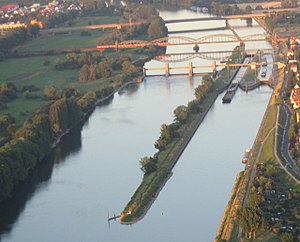Mainz rail bypass
| Mainz bypass | |||||||||||||||||||||||||||||||||||||||||||||||||||||||||||||||||||||||||||||||||||||||||||||||||||||||||||||||||||||||||||||||||||||||||||||||||||||||
|---|---|---|---|---|---|---|---|---|---|---|---|---|---|---|---|---|---|---|---|---|---|---|---|---|---|---|---|---|---|---|---|---|---|---|---|---|---|---|---|---|---|---|---|---|---|---|---|---|---|---|---|---|---|---|---|---|---|---|---|---|---|---|---|---|---|---|---|---|---|---|---|---|---|---|---|---|---|---|---|---|---|---|---|---|---|---|---|---|---|---|---|---|---|---|---|---|---|---|---|---|---|---|---|---|---|---|---|---|---|---|---|---|---|---|---|---|---|---|---|---|---|---|---|---|---|---|---|---|---|---|---|---|---|---|---|---|---|---|---|---|---|---|---|---|---|---|---|---|---|---|---|

Kostheim Bridge over the Main
|
|||||||||||||||||||||||||||||||||||||||||||||||||||||||||||||||||||||||||||||||||||||||||||||||||||||||||||||||||||||||||||||||||||||||||||||||||||||||
| Overview | |||||||||||||||||||||||||||||||||||||||||||||||||||||||||||||||||||||||||||||||||||||||||||||||||||||||||||||||||||||||||||||||||||||||||||||||||||||||
| Native name | Umgehungsbahn Mainz | ||||||||||||||||||||||||||||||||||||||||||||||||||||||||||||||||||||||||||||||||||||||||||||||||||||||||||||||||||||||||||||||||||||||||||||||||||||||
| Locale | Rhineland Palatinate and Hesse, Germany | ||||||||||||||||||||||||||||||||||||||||||||||||||||||||||||||||||||||||||||||||||||||||||||||||||||||||||||||||||||||||||||||||||||||||||||||||||||||
| Line number | 3525 | ||||||||||||||||||||||||||||||||||||||||||||||||||||||||||||||||||||||||||||||||||||||||||||||||||||||||||||||||||||||||||||||||||||||||||||||||||||||
| Technical | |||||||||||||||||||||||||||||||||||||||||||||||||||||||||||||||||||||||||||||||||||||||||||||||||||||||||||||||||||||||||||||||||||||||||||||||||||||||
| Line length | 15.1 km (9.4 mi) | ||||||||||||||||||||||||||||||||||||||||||||||||||||||||||||||||||||||||||||||||||||||||||||||||||||||||||||||||||||||||||||||||||||||||||||||||||||||
| Track gauge | 1,435 mm (4 ft 8 1⁄2 in) standard gauge | ||||||||||||||||||||||||||||||||||||||||||||||||||||||||||||||||||||||||||||||||||||||||||||||||||||||||||||||||||||||||||||||||||||||||||||||||||||||
| Electrification | 15 kV/16.7 Hz AC overhead catenary | ||||||||||||||||||||||||||||||||||||||||||||||||||||||||||||||||||||||||||||||||||||||||||||||||||||||||||||||||||||||||||||||||||||||||||||||||||||||
|
|||||||||||||||||||||||||||||||||||||||||||||||||||||||||||||||||||||||||||||||||||||||||||||||||||||||||||||||||||||||||||||||||||||||||||||||||||||||
Source: German railway atlas
The Mainz bypass railway (German: Umgehungsbahn Mainz) is a bypass around the Mainz Hauptbahnhof node primarily used for freight in the German states of Hesse and Rhineland Palatinate.
Even after Mainz Hauptbahnhof was moved to its present location in 1884, it soon became a bottleneck for traffic again. This was mainly due to the need to use the Mainz Tunnel, which only had two tracks.
In 1900, the Prussian-Hessian Railway Company (Königlich Preußische und Großherzoglich Hessischen Staatseisenbahnen or K.P.u.G.H.St.E.), supported by the governments of the Kingdom of Prussia and the Grand Duchy of Hesse, decided to solve this problem by building a rail bypass. While this required a complex route involving bridges, it avoided the need for freight traffic to run through Mainz Hauptbahnhof. The line entered operation on 2 May 1904.
The 15.1 km long line begins in Mainz-Mombach station. It crosses the Rhine on the Emperor Bridge, which was built for the line, reaching an area that is now in the city of Wiesbaden and crosses the Taunus Railway south of Wiesbaden Ost station. There are grade separated entrances and exits towards Wiesbaden and Koblenz.
The line runs in a wide arc around Mainz-Kastel. In Mainz-Kostheim it crosses the Taunus Railway again; at Kostheim junction it is possible to transfer to the line to Frankfurt.
Then it reaches the Kostheim Bridge over the Main, crosses the Rhine-Main Railway and runs in a wide arc into Mainz-Bischofsheim station. From there it is possible to continue via the Main Railway to Frankfurt Hauptbahnhof (and formerly to the now demolished Frankfurt main freight yard) and the Rhine-Main Railway to Darmstadt Hauptbahnhof.
...
Wikipedia

